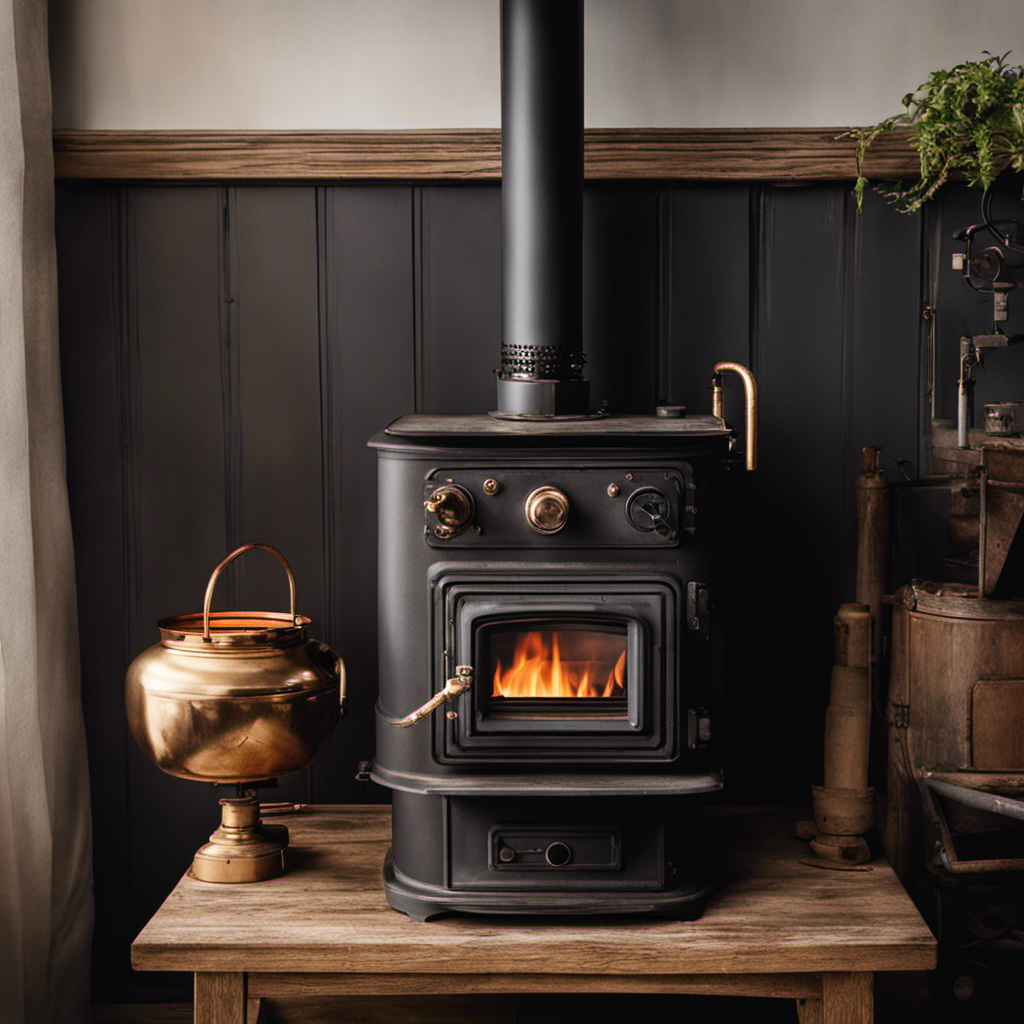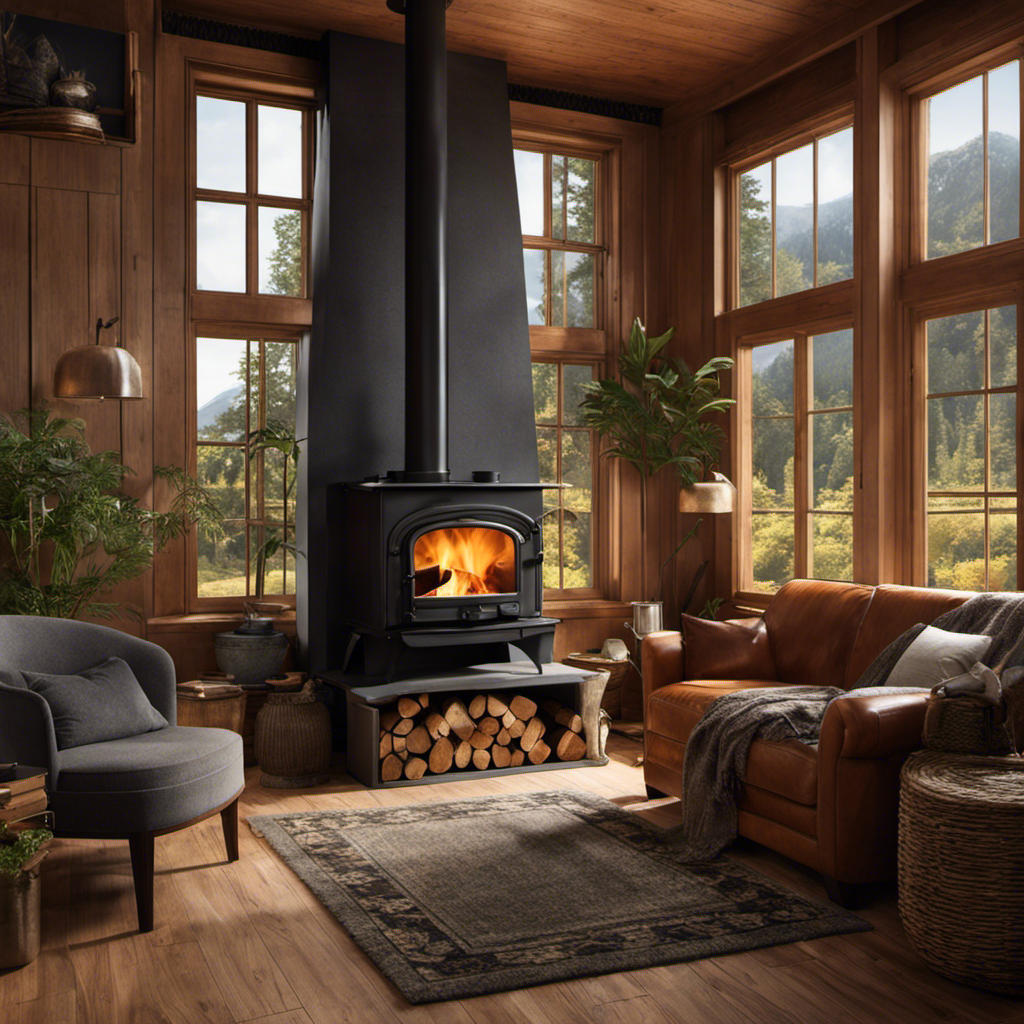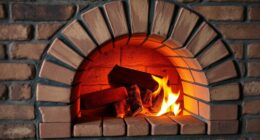To improve your wood stove's efficiency, start by using properly seasoned hardwood with a moisture content below 20%. Verify your chimney design is ideal: it should rise at least 2 feet above the roof and have minimal bends. Regularly clean the flue to prevent creosote buildup and monitor your stove's air supply for effective combustion. Try the top-down lighting method for easier ignition and adjust your air control based on smoke output. With focused maintenance and the right firewood, you'll notice better heat output and reduced emissions. There's plenty more to discover to enhance your stove's performance.
Key Takeaways
- Use properly seasoned hardwood with a moisture content of 15-20% for optimal combustion and heat output.
- Ensure your chimney design follows guidelines, including height and elbow limits, to maximize draft efficiency.
- Employ the top-down lighting method for efficient fire ignition and maintain proper air control during operation.
- Regularly clean and inspect your stove and chimney to prevent creosote buildup and ensure safe performance.
- Consider retrofitting with secondary air tubes and stainless steel components to enhance combustion efficiency and reduce emissions.
Understanding Wood Stove Efficiency
When you're using a wood stove, understanding its efficiency is key to maximizing heat output and minimizing smoke. Efficiency is primarily measured by how much wood energy gets converted into usable heat.
Modern high-efficiency models can achieve up to 90% efficiency, while older ones might only reach 60%. For example, the BTU rating of the Englander 10-Cpm highlights its ability to generate up to 50,000 BTUs, making it a strong contender regarding efficiency.
To get the most out of your stove, confirm that the firebox temperature stays above 1,100°F (600°C) for complete combustion. This temperature helps burn the wood thoroughly, reducing smoke emissions.
Using properly seasoned wood with a moisture content below 20% can also greatly enhance efficiency, yielding 12% more energy compared to fresh-cut wood. You'll notice the difference in both heat output and smoke levels.
Importance of Chimney Design

The design of your chimney plays an essential role in the overall efficiency of your wood stove. A properly designed chimney should exceed the height of your roof by at least 2 feet. This height guarantees ideal draft and prevents smoke from cooling too quickly, which can lead to inefficiency.
Additionally, keeping the stove pipe length under 7 feet minimizes resistance and promotes better air flow, enhancing your stove's heating performance. Proper chimney design is vital for maximizing heating efficiency, similar to how heat pumps utilize thermal energy transfer effectively.
To maintain proper pressure and avoid draught issues, limit your chimney design to no more than 2 elbows. Each elbow can add resistance, making it harder for smoke to escape.
Regular chimney cleaning is also vital; creosote buildup can restrict air flow and greatly reduce your stove's efficiency.
Selecting Quality Firewood

Choosing the right firewood is crucial for maximizing your wood stove's efficiency. You should aim to use wood with a moisture content between 15-20%. Higher moisture content leads to increased emissions and reduced heat output. Instead of softwoods, opt for seasoned hardwoods like oak and maple, which provide longer burn times and higher heat output.
To verify you're using the best firewood, consider the following:
| Wood Type | Moisture Content |
|---|---|
| Freshly Cut Wood | 40% or more |
| Properly Dried | 15-20% |
| Seasoned Hardwoods | 15-20% |
| Treated/Painted | Harmful Fumes |
Properly dried wood offers about 12% more energy than freshly cut wood, so aim for a drying period of at least six months to one or two years for best results. Store your firewood in a sunny, covered area to facilitate drying and prevent moisture absorption. Avoid using treated or painted wood, as they can emit harmful fumes and reduce your wood stove's efficiency.
Optimal Stove Placement

Finding the right spot for your wood stove is essential for maximizing heat distribution throughout your home. Positioning your stove centrally enhances its ability to distribute heat effectively, ensuring warmth reaches every corner of your space.
An open-plan layout is particularly beneficial, as it promotes better airflow and heat circulation, leading to improved overall heating efficiency. Additionally, consider incorporating breathtaking destinations into your home design to create a cozy retreat atmosphere that complements your wood stove's warmth.
When selecting your stove placement, think about future renovations. You want a location that allows for continued ideal performance and easy access for maintenance.
Avoid isolating your stove in corners or tucked away in rooms, as these placements can greatly hinder airflow and reduce its heating effectiveness.
Central placement not only maximizes heating efficiency but also supports integrated systems like water heating. By ensuring your wood stove has ample space around it, you encourage better airflow, which enhances its performance and can even extend the lifespan of the appliance.
Effective Fire Management

When managing your wood stove fire effectively, start by employing the top-down lighting method. Place larger logs at the bottom, followed by smaller kindling and newspaper on top. This arrangement promotes efficient ignition with minimal smoke production.
During the ignition phase, keep the air control fully open to guarantee peak draft, allowing the fire to establish itself before you regulate the airflow for a cleaner burn. Additionally, maintaining good indoor air quality is essential; using an ozone air purifier can help eliminate any lingering smoke odors while you enjoy your wood stove.
Once the fire is going, wait for the embers to glow before adding more wood. This step is vital for maintaining a steady and efficient burn rate, preventing smoldering that can increase smoke emissions.
Regularly check and clean the flue to prevent creosote buildup, which can hinder airflow and reduce combustion efficiency.
As you manage the fire, monitor the stove temperature and adjust the air supply based on the smoke output. A well-regulated airflow improves combustion quality, guaranteeing you get the most heat from your wood burner while reducing harmful emissions.
Enhancing Airflow and Combustion

To enhance airflow and combustion in your wood stove, it's essential to properly adjust the primary air supply for ideal initial combustion. Modern stoves typically require a small amount of primary air to prevent smoldering, which boosts efficiency.
Be cautious not to introduce any flushing improper items that might produce excess smoke when burned. Pay attention to the firebox temperature; you need at least 1100°F for effective secondary combustion. This process burns off hot gases at higher temperatures, promoting complete combustion and greatly reducing smoke and particulate emissions.
Additionally, monitoring smoke patterns from your chimney can provide valuable insights into your stove's performance. If you notice minimal smoke, it often indicates successful secondary combustion, meaning your stove is working efficiently.
To further improve combustion efficiency, consider installing an external air kit. This setup guarantees a consistent supply of fresh air, which is particularly beneficial in tightly sealed homes where airflow may be restricted.
Regular Maintenance Practices

To keep your wood stove running efficiently, you need to prioritize regular maintenance practices.
Start by cleaning the flue at least once a year to prevent creosote buildup and improve airflow. Regular maintenance is essential for guaranteeing peak performance and longevity of your stove, much like the importance of having a reputable home cleaning service.
Additionally, inspect the chimney for any blockages or damage to secure a clear draft and safe operation.
Cleaning the Flue Regularly
Cleaning the flue regularly is vital for keeping your wood stove running efficiently. Neglecting this important task can lead to creosote buildup, reducing airflow and increasing the risk of chimney fires. To guarantee peak performance, make it a habit to clean the flue at least once a year. If you use your stove heavily, consider cleaning it more often.
Additionally, maintaining proper ventilation during operation is essential for safety and efficiency, as emphasized in safety precautions regarding gas appliances.
A clean flue helps maintain a chimney temperature of at least 250°F, which prevents heat loss and promotes efficient burning. Use a chimney sweep or specialized brushes to remove soot and debris, guaranteeing unobstructed airflow. This won't only enhance combustion but also improve the overall efficiency of your wood stove.
Regular inspections are equally important as they can help identify any blockages or damage early on. Catching these issues before they escalate can save you costly repairs while keeping your stove operating at maximum efficiency.
Inspecting Chimney Condition
Regular inspections of your chimney are essential for maintaining the efficiency and safety of your wood stove. Check for blockages and any signs of damage that could obstruct airflow.
One of the biggest threats to your chimney is creosote buildup, which can lead to dangerous chimney fires. To prevent this, aim for a minimum annual chimney cleaning, especially if you burn wood regularly, as creosote can accumulate quickly.
Additionally, verifying that your wood stove operates efficiently can enhance your overall heating experience, much like energy-efficient models for pool cleaning that minimize operational costs. Use a chimney brush that's suitable for your flue size and material during your maintenance routine to effectively remove soot and creosote.
Make sure your chimney cap is in place, as it keeps debris and animals from entering, which can further obstruct airflow and reduce efficiency.
Additionally, monitor the chimney's height, confirming it exceeds the roof by at least 2 feet. This helps maintain proper draft and prevents smoke from cooling too quickly.
Environmental Impact Considerations

When considering the environmental impact of wood stoves, it's vital to understand how modern technology can greatly enhance efficiency and reduce emissions. High-efficiency wood stoves can cut emissions by up to 90% compared to older models, markedly improving air quality.
Additionally, utilizing renewable energy sources, such as geothermal energy, can complement wood heating systems and further decrease your carbon footprint. By operating your stove efficiently, you not only minimize fuel consumption and lower your costs but also reduce the overall carbon footprint associated with wood heating.
Choosing sustainably sourced local wood further boosts the environmental benefits. This practice minimizes transportation emissions and supports your local economy.
Additionally, keeping an eye on external weather conditions can optimize your stove's performance. Colder temperatures improve draft and efficiency, which helps reduce smoke emissions.
It is also important to be aware of local regulations regarding wood burning. Compliance with these guidelines can prevent excessive emissions and promote community health, enhancing the positive environmental impact of your wood stove.
Upgrading for Better Performance

If you want to boost your wood stove's performance, consider upgrading its airflow dynamics.
Effective strategies include retrofitting with advanced components that can lead to significant efficiency gains and cleaner burns.
Enhancing Airflow Dynamics
To achieve better performance from your wood stove, enhancing airflow dynamics is imperative. Upgrading your unit with secondary air tubes can greatly improve combustion by promoting the burning of hot gases. This means less smoke and fewer particulate emissions floating into the air.
Make sure to adjust the primary air supply properly; it's essential for ideal initial combustion. If it's not balanced, you might encounter smoldering, which leads to inefficient burning and increased emissions.
Regular inspection and cleaning of your air intake systems can prevent blockages, ensuring that the airflow dynamics remain efficient and consistent. This is important for maintaining a clean, efficient burn in your combustion chamber.
Consider retrofitting with insulated baffles to retain heat, increasing the residence time of flue gases for better combustion efficiency. Additionally, utilizing a stainless steel perforated air feed pipe can introduce superheated air into the process, enhancing secondary combustion.
This upgrade can cut your fuel consumption by up to 50%. By focusing on these airflow enhancements, you'll maximize your wood stove's efficiency and enjoy a more effective heating experience.
Retrofitting for Efficiency
Retrofitting your wood stove can transform it into a more efficient heating machine, drastically improving its performance. One effective way to achieve this is by installing secondary air tubes. These tubes enhance combustion by promoting the complete burning of exhaust gases, which can reduce emissions by up to 90% compared to older models.
Consider adding a stainless steel perforated tube in the firebox to create a vortex that improves heat distribution. This setup facilitates secondary combustion, further increasing your stove's overall efficiency.
Don't forget that regular cleaning of retrofitted components—like the new air intake and exhaust tubes—is essential. It helps prevent carbon blockage and maintains ideal airflow.
Additionally, upgrading the throat plate design can eliminate excessive smoke and creosote buildup, leading to a cleaner burning experience and reduced fuel consumption.
Engaging with community forums is also a great way to gather advice on retrofitting. Many users report a fuel consumption reduction of 50% or more after making these modifications.
Incorporating Advanced Components
Upgrading your wood stove with advanced components can take its efficiency to the next level. One effective upgrade is installing secondary air tubes, which greatly enhance combustion performance. These tubes promote secondary combustion and help reduce smoke emissions, making your stove more environmentally friendly.
Another great option is retrofitting with a stainless steel perforated tube. This creates a vortex effect in the firebox, improving heat distribution and overall efficiency.
You might also consider insulating the baffle. While it raises temperatures and enhances heat retention, make sure it's balanced to avoid hindering performance.
Adding an external air supply can also boost combustion efficiency. It provides a consistent and controllable airflow, which is particularly beneficial for tightly sealed homes.
Lastly, regular maintenance of your upgraded components, like the air intake and flue, is essential. This helps prevent carbon blockage and guarantees peak performance.
Engaging With Wood Stove Community

Engaging with the wood stove community can be incredibly beneficial for anyone looking to improve their stove's efficiency. By joining classic wood stove forums, you gain access to a treasure trove of user-generated knowledge about wood burning stove performance and modifications.
Many discussions attract hundreds of views, showcasing the collective wisdom available to you. You'll find users sharing their experiences with cost-effective upgrades for older models, which can greatly increase efficiency and reduce emissions.
These interactions allow you to receive tailored advice specific to your stove model, fostering collaboration among users to innovate and troubleshoot common issues. By participating in these forums, you can discover best practices and tips from seasoned users that enhance your wood stove's performance.
Engaging in discussions about stove care and maintenance can lead to noticeable improvements in operational practices. Users often report reductions in smoke and increased heat output after implementing shared techniques.
Frequently Asked Questions
How Do I Make My Wood-Burning Stove More Efficient?
To make your wood-burning stove more efficient, use seasoned hardwood, maintain a high firebox temperature, position it centrally for better heat distribution, clean the chimney regularly, and employ the top-down lighting method for ignition.
How Can I Burn Wood More Efficiently?
To burn wood more efficiently, use seasoned hardwood with low moisture content, implement the top-down lighting method, maintain high combustion temperatures, and regularly clean your stove. Adjust air supply for ideal combustion and heat production.
How Can I Make My Wood Stove Barrel More Efficient?
Your wood stove barrel could be the hottest thing since the sun if you retrofit with a secondary air intake! Insulate the baffle, clean regularly, and use seasoned hardwoods for maximum efficiency and warmth.
How Do I Make My Wood Stove Burn Slower?
To make your wood stove burn slower, regulate the air controls, use seasoned wood, and try the top-down lighting method. Position larger logs at the bottom to extend burn time effectively. Regularly clean your chimney too.
Conclusion
Improving your wood stove's efficiency not only saves you money but also enhances your comfort at home. By understanding the key factors like chimney design, firewood quality, and regular maintenance, you can maximize your stove's performance. Isn't it time you took a closer look at how you use your stove? Engaging with the wood stove community can also provide valuable insights and tips. With these strategies, you'll enjoy a warmer, more efficient home all winter long!











